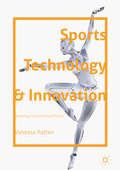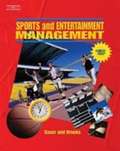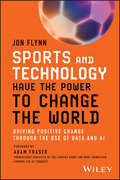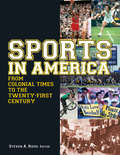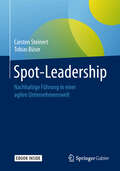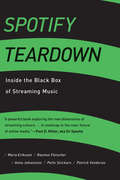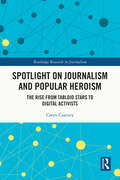- Table View
- List View
Sports Publicity: A Practical Approach
by Joe FavoritoIn the fourth edition of his groundbreaking guide to communications in sports, Joe Favorito draws on knowledge gained from interviews with thought leaders from across the sports industry to introduce the skills, knowledge, and techniques needed to become a successful communicator.The book outlines the history of sports communications; explores the most important professional themes, topics, and issues; and highlights exciting opportunities for future development. With a strong emphasis on professional practice and the day-to-day realities of working in sports and entertainment, the book covers all the core functional areas such as digital and social media strategy, crisis management, creative writing, the value of audio storytelling, and the role of communications in business. This new edition includes more international and diverse case studies, interviews, and best practices, reflecting on how the sport communications business has become more integrated since 2020 and considering lessons learned through and after the COVID-19 pandemic. It also includes expanded coverage of cause marketing, athletes as brands, social media, multicultural media relations, gaming, and brand integration. No other book offers such a valuable insider’s view of the sports communications industry or the importance of PR and media relations in building successful sports organizations.Sports Publicity: A Practical Approach is essential reading for all students working in sport business, marketing, or communications and any PR practitioner looking to improve their professional skills.The author maintains a podcast of updated best practices, The CUSP Show, which is widely available, as well as a blog of best practices at joefavorito.com. Both of these resources are perfect companions to this book.
Sports Sponsoring: Requirements and Practical Examples for Successful Partnerships
by Manfred Bruhn Peter RohlmannThis book provides basic knowledge and understanding for successful sports sponsorship. The structure of the book is based on the individual phases of analysis, planning, implementation and monitoring of sponsorship concepts. The planning process with its individual phases is presented as an introduction to the classification of sponsorship as an element of sports marketing and the various forms of sports sponsorship. Building on this, the situation analysis, target definition, target group planning, strategic orientation, budgeting, selection of sponsorships, integration into the communication and sponsorship mix, design of sponsorships, success control, legal aspects, services of sports agencies and trends in the use of sports sponsorship are the subject of detailed treatment. In a concluding chapter, the 2022 FIFA World Cup is used as an opportunity to highlight the critical points of contention in the discussion about sports sponsorship of major events. The question of conclusions for future sporting events is also raised. In order to not only propagate a tangible practical relevance, but to have it underpinned by experts, the authors have agreed to cooperate with the sponsorship association S20 - The Sponsors' Voice with regard to the inclusion of case studies in the book. Swiss companies also took part in the case studies. Numerous examples - such as Allianz SE, Bell Food Group AG, Deutsche Kreditbank AG (DKB), Deutsche Telekom AG, HypoVereinsbank/UniCredit Bank AG, ING Deutschland, Mercedes-Benz AG, Novartis International AG, Penny Markt GmbH (REWE Group), Raiffeisen Schweiz, Viessmann Climate Solutions SE, Warsteiner Brauerei Haus Cramer KG - illustrate what successful sports sponsorship can look like and provide concrete suggestions for its implementation in everyday life.
Sports Sponsorship and Branding: Global Perspectives and Emerging Trends (World Association for Sport Management Series)
by James J. Zhang Ho Keat LengThis book takes a close look at branding and sponsorship in sport in the age of digital media. It examines how branding and sponsorship have evolved in response to the challenges and opportunities of new technologies. Featuring the work of leading international sport business researchers from four continents and twelve countries, the book explores key contemporary topics including esports, Name and Image Likeness (NIL) rights, viewer experience, machine learning, social media use by athletes, sport migration, and the impact of COVID-19. It presents cutting-edge cases and new data across sports and events including the Olympics, the NBA, international football, the rafting world championships, and collegiate sports. The book is an essential resource for advanced students, researchers, practitioners and policy-makers working in sport business and management, sport marketing, digital marketing, marketing communications or brand management.
Sports Technology and Innovation: Assessing Cultural and Social Factors
by Vanessa RattenThe aim of this book is to focus on the role of sports technology and the way that the innovation process is managed. This will help understand how technology is developed and integrated into the sports context. This is important particularly due to rapid technological advancements developed in sport being applied to other industries. The book will focus on the different types of sports technology from increment to radical innovations, including looking at product, process, and service innovations. It will be one of the first books to specifically focus on sports technology and innovation. It will be useful to innovation management researchers, enthusiasts and sports practitioners interested in how to compete based on technological advancements.
Sports Tourism: Participants, Policy And Providers
by Chris Bull Mike WeedSports Tourism: participants, policy and providers is an unparalleled text that explains sports tourism as a social, economic and cultural phenomenon that stems from the unique interaction of activity, people and place. Unlike other texts, it seeks to present sports tourism as a unique area that produces its own unique issues, concerns and controversies.The text tackles these issues from three viewpoints: participants: examining the profiles, motivations and behaviour patterns of sports tourists to create a typology of participants policy: analyses the response by policy makers to this phenomenon and the problems of achieving integration between two sectors with historically different cultures providers: their motivations, aims, objectives and strategies Illustrated by international case studies in each chapter, and with four extended case study chapters, Sports Tourism: participants, policy and providers examines this area using real life experiences and concrete evidence.
Sports Tourism: Participants, Policy and Providers
by Chris Bull Mike WeedSports Tourism: Participants, Policy and Providers is an unparalleled text that explains sports tourism as a social, economic and cultural phenomenon that stems from the unique interaction of activity, people and place. Unlike other texts, it establishes sports tourism as a unique area that produces its own unique issues, concerns and controversies. Extensively revised with cutting edge new material based on the latest research in the field, this edition uses recent international case studies to illustrate how theory is used in practice. The text tackles the complex and distinctive issues this sector faces from three viewpoints: participants: examining the profiles, motivations and behaviour patterns of sports tourists to create a participation model policy: analyzes the response by policy makers to this phenomenon and the problems of achieving integration between two sectors with historically different cultures providers: their motivations, aims, objectives and strategies. Now in its second edition, this book is an essential resource for those studying, teaching or working in sports tourism.
Sports and Entertainment Management
by Ken Kaser John R. Brooks Jr.Learn marketing and business management while focusing on sports with SPORTS AND ENTERTAINMENT MANAGEMENT. This marketing and business management textbook uses topics in the sports and entertainment industries to cover the basic functions of management as outlined in national and state standards. Along the way, you'll also discover powerful information about leadership, finance, product and people management, customer relations, sales, and much more.
Sports and Entertainment Marketing
by Dotty Boen Oelkers Ken KaserSPORTS AND ENTERTAINMENT MARKETING 3E continues to use sports and entertainment topics as the foundation for teaching marketing concepts. Each marketing function is incorporated throughout the text and is highlighted with an icon to indicate how it is used in the marketing process.
Sports and Entertainment Marketing
by Dotty Boen Oelkers Ken KaserSPORTS AND ENTERTAINMENT MARKETING, 4E continues to use sports and entertainment topics as the foundation for teaching marketing concepts. Each marketing function is incorporated throughout the text and is highlighted with an icon to indicate how it is used in the marketing process.
Sports and Technology Have the Power to Change the World: Driving Positive Change Through the Use of Data and AI
by Jon FlynnDiscover how the explosions in data analytics, AI, and digital communication are benefiting sports and sports fans around the world In Sports and Technology Have The Power To Change The World: Driving Positive Change Through The Use of Data and AI, the Director of Microsoft Sports, Jon Flynn, delivers an insightful new take on the transformative power of sport and its ability to unite people, break down barriers, and generate positive change. The author explains the critical role that technology has played in growing the impact of sporting events and enabling social change while fostering community improvement. In the book, you’ll explore many of the ways in which sports, enabled by new tech, have made significant contributions to society and promoted individual development, health, and wellbeing. You’ll also find: Discussions of green technologies and climate and sustainability initiatives linked to sport, with a case study about the 2022 Beijing Winter Olympics Explorations of the impact of advanced data analytics, with a case study focusing on the 2013 NBA Final matchup between the Miami Heat and the San Antonio Spurs How sport scientists are optimizing player performance Perfect for anyone interested in the intersection of sport, society, and technology, Sports and Technology Have The Power To Change The World is an easy to read and endlessly fascinating look at how the unique combination of athletics and tech makes the world a better place.
Sports in America: From Colonial Times to the Twenty-First Century
by Steven RiessProvides practical help for the day-to-day concerns that keep managers awake at night. This book aims to fill the gap between the legal and policy issues that are the mainstay of human resources and supervision courses and the real-world needs of managers as they attempt to cope with the human side of their jobs.
Sports on Television: The How and Why Behind What You See
by Dennis DeningerIn Sports on Television, Dennis Deninger provides an all-encompassing view of the sports television industry. He progresses from the need for this book, to the history of the industry and discipline, to the pioneering events of sports broadcasting and sports television, to a nuts-and bolts, behind-the-scenes look at a sports television production. All the while, he examines the impact that sports and the mass media have had (and are continuing to have) on one another and on society.
Sports: The All-American Addiction
by John R. GerdyJohn R. Gerdy knows sports inside-out. He has been an All-American basketball player whose college jersey was retired. He was briefly a professional player. Later he served as an associate commissioner in the NCAA's Southeastern Conference and as a legislative and ethical advisor to the NCAA and the Knight Commission. Currently he teaches courses on sports administration. Now, in Sports: The All-American Addiction, he brings his insights and observations together in a radical, critical evaluation of the impact of sports on American life. This book argues that our society's huge investment in organized sports is unjustified. Ardent boosters say that sports embody the “American Way,” developing winners by teaching lessons in sportsmanship, teamwork, and discipline. In fact, Gerdy writes, modern sports are eroding American life and undermining traditional American values essential to the well-being of the nation and its people. Like a drug, this obsession allows Americans to escape problems and ignore issues. Gerdy asks tough questions. Have sports lost their relevance? Is it just mindless entertainment? Is our enormous investment in sports as educational tools appropriate for a nation that needs graduates to compete in the information-based, global economy of the twenty-first century? Do organized sports continue to promote positive ideals? Or, do sports, in the age of television, corporate sky boxes, and sneaker deals, represent something far different? Boldly making his case, Gerdy detects five causes for alarm. A violent, win-at-all-cost mentality exists. A greater number of spectators are idly watching the few elite athletes. An athletic culture that is anti-intellectual systematically creates “dumb jocks.” While bridges, inner-cities, and schools are crumbling, tremendous sums of tax dollars vanish to wealthy owners, millionaire players, and to college athletic programs. Studies show that sports are no more effective in promoting equality than any other American institution. Can organized sports be restructured? The author concludes with a series of daring suggestions for change.
SportsWorld: An American Dreamland
by Robert LipsyteTough and witty, SportsWorld is a well-known commentator’s overview of the most significant form of mass culture in America—sports. It’s a sweaty Oz that has grown in a century from a crucible for character to a complex of capitalism, a place where young people can find both self-fulfillment and cruel exploitation, where families can huddle in a sanctuary of entertainment and be force fed values and where cities and countries can be pillaged by greedy team owners and their paid-for politicians. But this book is not just a screed, it’s a guided visit with such heroes of sports as Muhammad Ali, Billie Jean King, Kareem Abdul-Jabbar, and Joe Namath, who the author knew well, and with some he met in passing, like Richard Nixon, who seemed never to have gotten over missing the cut in college varsity football, a major mark of manhood. We see how SportsWorld sensibilities help elect our politicians, judge our children, fight our wars, and oppress our minorities. And now featuring a new introduction by the author,SportsWorld is a book that will provide the foundation for understanding today’s world of sports and the time of Trump. In the America of 2017—where the SuperBowl is worth billions, athletes are penalized or forced out of sports for political and anti-racist activism, and Title IX is constantly questioned and undermined—Robert Lipsyte’s 1975 critique remains startlingly and intensely relevant.
Sportsponsoring: Grundlagen, Konzeption Und Wirkungen
by Manfred Schubert Stefan WalzelSportsponsoring ist die mit Abstand bedeutendste Erscheinungsform des Sponsorings. Es zählt zu den zentralen Instrumenten der Markenkommunikation von Unternehmen und zugleich zu den wichtigsten Einnahmequellen des Zuschauersports. Das Lehrbuch stellt Sportsponsoring als Kommunikations- und Finanzierungsinstrument in seiner ganzen Breite und Vielfalt vor. Thematisiert werden u.a. Akteure und Zielgruppen, die Erfolgs- und Wirkungskontrolle von Sportsponsoring-Maßnahmen, unerwünschte Effekte wie Ambush-Marketing sowie die soziale Verantwortung von Sponsoren und Gesponserten. Das Buch bietet eine gute Einführung für Studierende, enthält aber auch wertvolle Informationen für ehren- oder hauptamtlich Tätige im Sport und für Marketingmanager in Unternehmen. Lernziele, Verständnis- und Diskussionsfragen, Zusammenfassungen sowie weiterführende Links und Literaturempfehlungen zu jedem Kapitel erleichtern die Nutzung des Buches, sichern den Lernerfolg und regen zur vertiefenden Auseinandersetzung mit einzelnen Themen an.
Sportsponsoring: Voraussetzungen und Praxisbeispiele für erfolgreiche Partnerschaften
by Manfred Bruhn Peter RohlmannDieses Buch schafft Basiswissen und Verständnis für ein erfolgreiches Sportsponsoring. Der Aufbau des Buches orientiert sich an den einzelnen Phasen der Analyse, Planung, Umsetzung und Kontrolle von Sponsoringkonzeptionen. Einführend zur Einordnung des Sponsoring als Element der Sportvermarktung und den unterschiedlichen Erscheinungsformen des Sportsponsoring wird der Planungsprozess mit den einzelnen Phasen dargestellt. Darauf aufbauend sind die Situationsanalyse, Zielfestlegung, Zielgruppenplanung, Strategische Ausrichtung, Budgetierung, Auswahl von Sponsorships, Integration in den Kommunikations- und Sponsoringmix, Gestaltung von Sponsorships, Erfolgskontrolle, Rechtsaspekte, Leistungen von Sportagenturen und Tendenzen im Einsatz des Sportsponsoring Gegenstand einer ausführlichen Behandlung. In einem abschließenden Kapitel wird die Fußball-Weltmeisterschaft 2022 zum Anlass genommen, die kritischen Streitpunkte in der Diskussion über Sportsponsoring von Großereignissen aufzuzeigen. Auch wird die Frage von Schlussfolgerungen für kommende sportliche Ereignisse gestellt.Um einen spürbaren Praxisbezug nicht nur zu propagieren, sondern von Fachleuten untermauern zu lassen, haben die Autoren eine Kooperation mit der Sponsoring-Vereinigung S20 – The Sponsors‘ Voice hinsichtlich der Einbeziehung von Fallstudien in das Buch vereinbart. Auch Schweizer Firmen haben sich an den Fallstudien beteiligt. Zahlreiche Beispiele – wie Allianz SE, Bell Food Group AG, Deutsche Kreditbank AG (DKB), Deutsche Telekom AG, HypoVereinsbank/UniCredit Bank AG, ING Deutschland, Mercedes-Benz AG, Novartis International AG, Penny Markt GmbH (REWE Group), Raiffeisen Schweiz, Viessmann Climate Solutions SE, Warsteiner Brauerei Haus Cramer KG – verdeutlichen, wie erfolgreiches Sportsponsoring aussehen kann und geben konkrete Anregungen für dessen Implementierung im Alltag. Der InhaltSponsoring als Element der Sportvermarktung und des SportsponsoringErscheinungsformen des SportsponsoringPlanungsprozess des SportsponsoringZiele und Zielgruppen des Sportsponsoring als AusgangspunktStrategische Ausrichtung des SportsponsoringAuswahl von Sponsorships im SportOperative Gestaltung des SportsponsoringIntegration des Sportsponsoring in die Marketing- und UnternehmenskommunikationBudgetierung des SportsponsoringErfolgskontrolle im SportsponsoringLeistungen von SportagenturenTendenzen im Einsatz des Sportsponsoring
Spot-Leadership: Nachhaltige Führung In Einer Agilen Unternehmenswelt
by Carsten Steinert Tobias BüserDieses Buch vermittelt fundiert und praxisnah, wie Führungskräfte in einer immer komplexer werdenden Welt Unternehmen und ihre Mitarbeiter zum Erfolg führen können. Die Lösung lautet Spot-Leadership. Das bedeutet, sich als Führungskraft von den vielfältigen Situationsvariablen nicht verwirren zu lassen, sondern diese mit Übersicht und System am jeweiligen Punkt (Spot) zu gestalten. Dafür stellen die Autoren einen praktischen Führungs-Kompass vor. Dieser besteht aus sieben Erfolgsfaktoren, die für nachhaltige Führung in agilen Situationen aufeinander abgestimmt werden müssen. Zu jedem der sieben Erfolgsfaktoren werden die wichtigsten theoretische Ansätze und empirische Studien dargestellt und mit zahlreichen Fallbeispielen und praktischen Tipps verdeutlicht, um daraus für die Führungspraxis brauchbare Instrumente und Handlungsoptionen abzuleiten.
Spotfire: Managing a Multinational Start-Up
by Walter Kuemmerle Chad EllisSpotfire, a software start-up, must address the question of dividing its effort between Sweden and the United States in addition to raising venture capital, obtaining new customers, and managing early-stage growth.
Spotify Teardown: Inside the Black Box of Streaming Music (The\mit Press Ser.)
by Pelle Snickars Patrick Vonderau Maria Eriksson Anna Johansson Rasmus FleischerAn innovative investigation of the inner workings of Spotify that traces the transformation of audio files into streamed experience.Spotify provides a streaming service that has been welcomed as disrupting the world of music. Yet such disruption always comes at a price. Spotify Teardown contests the tired claim that digital culture thrives on disruption. Borrowing the notion of “teardown” from reverse-engineering processes, in this book a team of five researchers have playfully disassembled Spotify's product and the way it is commonly understood.Spotify has been hailed as the solution to illicit downloading, but it began as a partly illicit enterprise that grew out of the Swedish file-sharing community. Spotify was originally praised as an innovative digital platform but increasingly resembles a media company in need of regulation, raising questions about the ways in which such cultural content as songs, books, and films are now typically made available online.Spotify Teardown combines interviews, participant observations, and other analyses of Spotify's “front end” with experimental, covert investigations of its “back end.” The authors engaged in a series of interventions, which include establishing a record label for research purposes, intercepting network traffic with packet sniffers, and web-scraping corporate materials. The authors' innovative digital methods earned them a stern letter from Spotify accusing them of violating its terms of use; the company later threatened their research funding. Thus, the book itself became an intervention into the ethics and legal frameworks of corporate behavior.
Spotify: Cómo una startup sueca ganó la batalla por el dominio del audio a Apple, Google y Amazon
by Jonas Leijonhufvud Sven CarlssonLa historia completa de la plataforma de audio por streaming más grande del mundo En 2011, Daniel Ek, el joven fundador de Spotify, por fin logró el lanzamiento de su compañía en Estados Unidos, a pesar de que Steve Jobs había hecho lo posible porque ese momento nunca sucediera. La startup sueca había entrado al campo de batalla para cambiar las reglas del juego en el negocio de la música. Spotify apenas había ganado una batalla, pero aún no la guerra: ahora tendría que luchar en contra y a favor de las grandes discográficas, al tiempo que seguía tratando de triunfar en la carrera de la rentabilidad. A partir de cientos de entrevistas y fuentes —entre las que destacan Mark Zuckerberg, Steve Jobs, Taylor Swift, Jay-Z, Sean Parker, Pony Ma Huateng y Jimmy Loving—, los autores reconstruyen la fascinante historia de una de las compañías que ha revolucionado la forma en que el mundo consume audio. Un relato equiparable al de David y Goliat que, además de revelador, muestra cómo la convicción, la voluntad implacable y los sueños son clave para los pequeños empresarios que se enfrentan a los gigantes de la tecnología.
Spotlight on Journalism and Popular Heroism: The Rise from Tabloid Stars to Digital Activists (Routledge Research in Journalism)
by Caryn CoatneyThis book offers fresh insights into the central role of journalism in shaping popular memories of community heroism in times of crisis. Further, it challenges familiar assumptions about Hollywood celebrity reporting and shows journalists’ active role in connecting popular culture icons with local communities.This book showcases fresh insights into how audiences collaborated and contributed to these widespread stories. The chapters included show how His Girl Friday, a Hollywood classic about tabloid newsroom stars, became a must-see movie for journalists, inspiring hundreds to choose the profession. Other appearances include Peter Fleming (James Bond creator Ian Fleming’s brother) and Norman Rockwell who helped create heroic characters in the news that became global symbols of community leadership. This offers a look at digital news activists who recreated heroic icons in social media to champion human rights in the Middle East. The historical and contemporary case studies offer insights into larger news trends that have contributed to the enduring popularity of these diverse, heroic identities in journalism.Presenting unique views of community, collaborative and interactive journalism, this book will be a valuable resource to students and scholars of journalism, communication, media and political history, as well as professionals already operating within the field of journalism.
Spotting Assumptions, Estimates, and Biases: The Art of Finance
by John Case Karen Berman Joe KnightUnderstanding the "artistic" aspects of finance is key to developing financial intelligence. This chapter examines how financial professionals make estimates and assumptions using accruals and allocations, depreciation, and valuation as examples.
Spotting Institutional Voids in Emerging Markets
by Tarun Khanna Krishna G. PalepuWith the demise of communism, many countries in the world are striving to build their economic activity around markets and to participate in free trade arrangements, such as the World Trade Organization (WTO), European Union (EU), and North American Free Trade Agreement (NAFTA). Addresses several issues critical to understanding the unique nature of emerging markets relative to their more mature counterparts. What is the fundamental challenge in building well-functioning markets? On which sets of institutions do advanced markets rely to resolve these challenges? What makes building these institutions complex? What happens when some of these institutions are either absent or underdeveloped in an economy? How does one spot these institutional voids?
Spotting and Responding to Institutional Voids: Identifying Opportunities in Emerging Markets
by Tarun Khanna Krishna G. PalepuThe trick to defining and executing business strategy in emerging markets? Identifying the key institutions missing from developing economies-like absent or unreliable sources of market information, an uncertain regulatory environment, or inefficient judicial systems-and building businesses that will help fill those voids. This chapter, from the book "Winning in Emerging Markets" by two experts in the field, equips managers with toolkits to spot and respond to institutional voids in product, labor, and capital markets, and the resulting obstacles and business opportunities. These toolkits provide a series of questions that will help you avoid easy-to-anticipate mistakes and identify unexpected sources of competitive advantage-whether yours is a foreign or domestic organization. This chapter was originally published as Chapter 2 of "Winning in Emerging Markets: A Road Map for Strategy and Execution."



